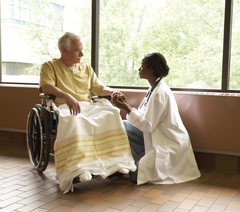Vulvovaginal disorders common but commonly misdiagnosed
Nearly one in eight women have chronic vaginal pain. Although there's a lack of regular training in internal medicine, the gold standards for diagnosis remain the history and physical, pH and saline wet mount, and a whiff test and biopsy (if indicated).
More than 10% of office visits are due to vaginal symptoms, and 16% of American women have chronic vulvar pain. Yet, “There's a huge problem,” Elizabeth G. Stewart, MD, told attendees at a session on vulvovaginal disorders at Internal Medicine 2011. “There's virtually no vulvovaginal training for clinicians.”
Dr. Stewart, an assistant professor of obstetrics and gynecology at Harvard Medical School, said that vulvovaginal diagnosis is complicated because dozens of disorders can present with similar symptoms. Clinicians also tend to rely on patients' self-diagnosis and manage their problems by phone, or don't do a physical exam before treating, which leads to incorrect therapies.
Physicians examining a woman with vulvovaginal symptoms must consider many differential diagnoses, Dr. Stewart said. Symptoms can be caused by contactants, an allergy, atrophy, a drug reaction or sexually transmitted infections, among other factors. To narrow it down, physicians should ask themselves whether the problem results from infection, low estrogen, a dermatological source, disease elsewhere in the body, a drug, cancer or a precancerous condition, or any combination of these factors.
The gold standards for diagnosis of a vulvovaginal disorder are the history and physical, pH and saline wet mount, a whiff test and a biopsy (if indicated), Dr. Stewart noted. “No one can just look at vaginal secretions and say that they know [what they are],” she said. She also stressed the diagnostic importance of a normal pH, between 3.5 and 4.5.
“This is the most valuable 60 seconds of test that you can imagine, because if the pH is normal, you do not have a woman with infection,” she said. Candidiasis is still a possibility because, as Dr. Stewart said, “Candida does what it wishes,” but other causes of vaginitis can be ruled out.
A pH above 4.5, however, doesn't positively rule in an infection. That result can also point to bleeding, recent intercourse, contamination from cervical secretions, or atrophic vaginitis due to menopause, as well as vaginitis or vaginosis. “An elevated pH is a nonspecific finding,” Dr. Stewart said.
To confirm that vaginosis is what you're seeing, Dr. Stewart recommended reviewing the Amstel criteria: elevated pH, grey-white discharge, clue cells, and a positive whiff test. Three of these four are necessary for diagnosis, she noted. She also pointed out that although bacterial vaginosis causes discharge and odor, it's unlikely to cause soreness, burning or dyspareunia.
Bacterial vaginosis has an extraordinary recurrence rate, Dr. Stewart said: 25% to 30% by three months and 80% by nine months. “This is so important for women to know when you hand out the Flagyl [metronidazole] for the first time,” she said. “You tell them, ‘You might see this back in a couple of months.’”
But the treatment doesn't need to be metronidazole. For bacterial vaginosis, it's “dealer's choice” among metronidazole, clindamycin or tinidazole, Dr. Stewart said.
For yeast infections, accurate diagnosis can be difficult, Dr. Stewart said, because a patient needs to stop taking antifungals for more than two weeks before she's tested. Even just taking one dose of an over-the-counter yeast medication can throw off the results of a test. Also, microscopy needs to be supplemented with culture or a probe for Candida, because “Half the time you will not see Candida under the microscope,” she said. If this is the case, the patient should be seen when symptoms are flaring. Alternatively, she could do a home culture when she's symptomatic, Dr. Stewart said.
Many women with uncomplicated cases of candidiasis will self-treat and won't present to a physician at all, Dr. Stewart said. Complicated cases, such as recurrent or severe vulvovaginal candidiasis, are more likely to end up in a physician's office. For Candida albicans, the recommended treatment is fluconazole, 100, 150 or 200 mg every third day for a total of three doses. Dr. Stewart noted that fluconazole at these doses is not hepatotoxic. However, the drug is not approved for use in pregnant women and has many interactions with P450 drugs.
Dr. Stewart's talk also addressed lichen sclerosus, “an awful disease” with a wider incidence than previously thought. Its cause is unknown but it's believed to have an autoimmune association, she said. Incidence peaks in childhood around the age of 5 and later in life at menopause, affecting 1 in 30 elderly women, 1 in 50 women in a general gynecology practice and 1 in 300 to 1,000 patients referred to dermatologists.
Symptoms of lichen sclerosus can range from intense pruritus severe enough to interfere with sleep to dull burning pain to no symptoms at all. Other symptoms include dyspareunia from introital narrowing, perianal fissuring and painful defecation. Clinical signs include pallor, loss of pigmentation and “cigarette paper” wrinkling of the skin; purpura and ecchymoses; and figure-of-eight extension around the perianal area. If lichen sclerosus is not recognized and treated, it's possible for patients to lose all of their vaginal architecture, Dr. Stewart said.
“The good news about lichen sclerosus is that we learned in 1988 that you can stop it in its tracks,” Dr. Stewart said. Topical steroids are the first-line treatment of choice and should be applied once or twice daily for four to 12 weeks, then tapered to once daily to twice weekly for maintenance.
“This is such an important message,” she said. “If you stop steroids, the disease will come back. It's a chronic problem that isn't going to go away.”





